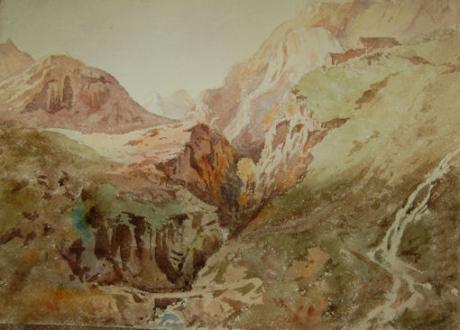"Nov 3 1858"
Mountain village and valley on the approach to the natural amphitheatre known as the Cirque de Gavarnie, in Hautes-Pyrénées département, Midi-Pyrénées région, southwestern France. Gavarnie lies in the central Pyrenees, on the French side of the Franco-Spanish frontier. The village, at an elevation of 4,452 feet (1,357 m) in the valley of the Gave (torrent) de Pau, was a resting place in medieval times for pilgrims traveling to Santiago de Compostela in northwestern Spain, which is one of the chief shrines of Christendom. The Vignemale (Occitan: Vinhamala, Aragonese: Comachibosa), at 3298 metres, is the highest of the French Pyrenean summits, in the border with Spain (the highest in the whole of the range is Pic Aneto).The Vignemale is the name given to the mountain massif which actually straddles into Spain. It consists of several distinct summits, the predominant ones being Grand Vignemale or Pique-Longue (3298m), Pointe Chausenque (3204m) and Petit Vignemale (3032m). The Vignemale is also the site of the second largest of the Pyrenean glaciers (after Aneto's one), the Ossoue (with around 0,6 km2), across which is the "voie normale" or standard route to the summit.One of its most dramatic aspects is the North Face upon which there are a number of serious ascent routes requiring skill and commitment. Below the North Face is the impressively situated mountain refuge - the Refuge des Oulettes de Gaube. The approach from the north entails a delightful walk up to and around the picturesque Lac de Gaube giving increasingly dramatic views of the mountain. Almost synonymous with the Vignemale is the name of Count Henry Russell, an eccentric of the Victorian era who developed a life-long passion for the mountain.
John Louis Petit was born at Ashton-under-Lyne, Lancashire, son of John Hayes Petit. He was educated at Eton, and contributed to the "Etonian". He was elected to a scholarship at Trinity College Cambridge in 1822, graduated BA in 1823 and MA in 1826, and on 21st June 1850 he was admitted "ad eundem" at Oxford. He took holy orders in 1824, but undertook no parochial work. Petit showed a taste for sketching in early years. His favourite subject was old churches, and a great part of his life was spent in visiting and sketching them. In 1839 he made his first extensive tour of the continent. The results appeared in his "Remarks on Church Architectire" (1841, 2 vols which had illustratuions. It was followed in 1846 by "Remarks on Church Architectural Character" Royal folio format.In the same year Petit published a lecture which he had delivered on 24th Feb 1846 to the Oxford Society for promoting the study of Gothic Architecture, under the title "Remarks on the Principles of Gothic Architecture as applied to ordinary Parish Churches". It was succeeded by "Architectire of Tewksbury Abbey Church". Royal svo 1846. " Architectural notes in the neighbourhood of Cheltenham"and "Remarks on Wimborne Minster", 1847. "Remarks on Southwell Minster". With numerous good illustrations. 1848. "Architectural Notices relating to Churches in Gloucestershire and Susse". 1849. "Architectural Notices of the Curious Church of Gillingham.Norfolk". And an "Account of Sherborne Minster". 1850. In 1852 Petit published an account of Brinkburn Priory". In 1854 appeared Petit's principal work. "Architectural Studies in France", imperial SVO. It was beautifully illustrated with fine woodcuts and facsimiles of anastic drawings by the author and his companion, Professor Delamotte. It showed much learningand observation, and threw light upon the formation of Gothic in France, and on the differences between English and French Gothic. A new edition , revised by Edward Bell, FSA, with introduction, notes and index, appeared in 1890. The text remained unaltered but the illustrations were reduced in size, and a few added from Petit's unused woodcuts. In 1864-65 he travelled in the East and executed some striking drawings. He died in Lichfield on 2 Dec 1868, from a cold caught while sketching and was buried in St Micheal's Churchyard. Petit was the founder of the British Archealogical Institute at Cambridge in 1844. He was also FSA, an honoury member of the Institute of British Architects, and a governor of Christ's hospital.

